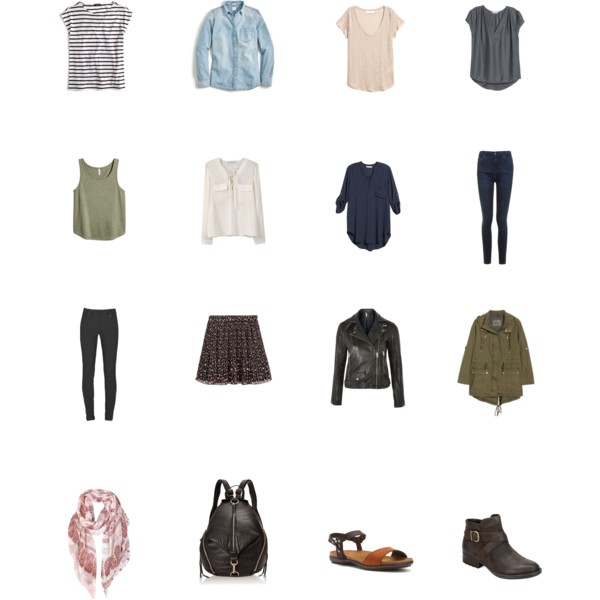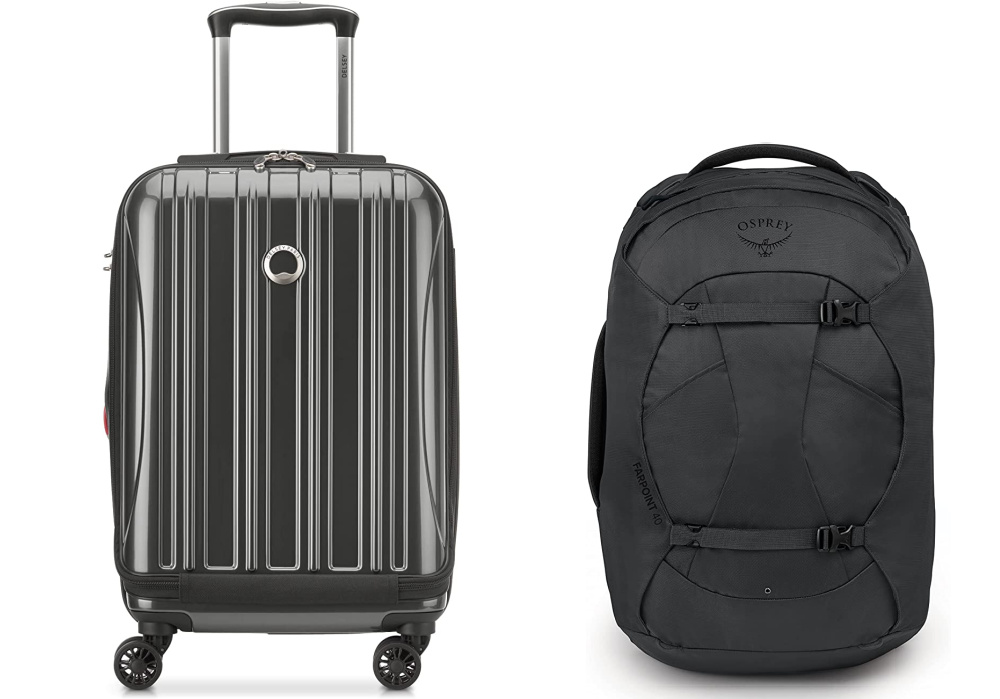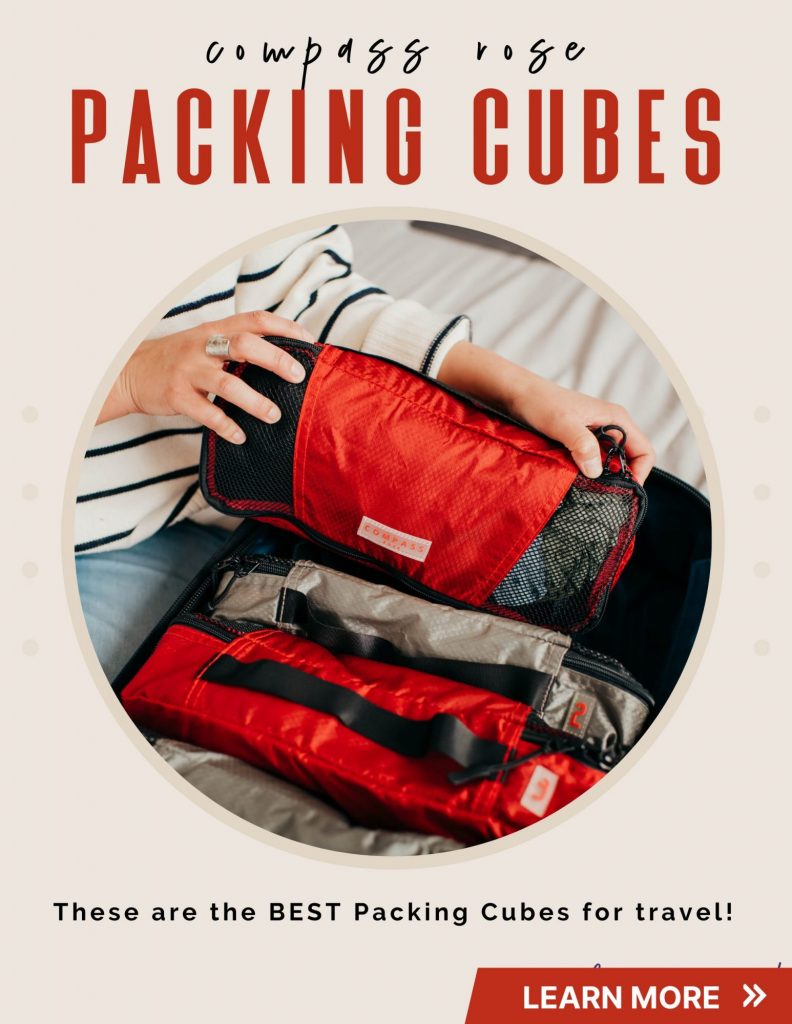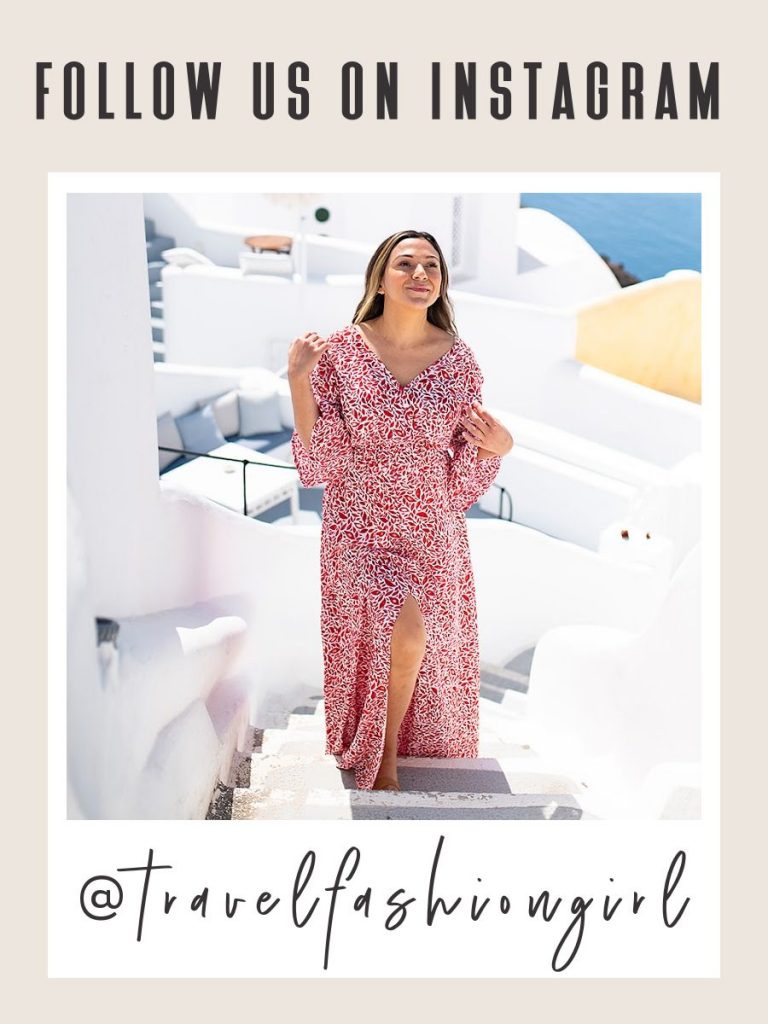Support TFG by using the links in our articles to shop. We receive a small commission (at no extra cost to you) so we can continue to create helpful free content. We earn from qualifying purchases made to the featured retailers. Thank you, we appreciate your support!
One of the trickiest things about packing for Europe is being prepared for variations in the weather. We’re sharing examples of what to pack for Europe during various times of the year. You can use this packing list for 2 weeks in Europe, or even longer! Just wash, rinse, mix and match, and repeat!
Packing List for 2 Weeks in Europe
While this packing list is for 2 weeks in Europe, you can adapt it for a trip of any duration. The trick to traveling for long periods of time is to re-wear clothing and to do laundry once a week or as needed.
On my first trip to Europe in March 2007, I did a two week coach tour through different countries and packed a large 36” suitcase, plus a 22” carry on. Almost all the clothing I packed went unworn.
I got so tired of getting all my luggage in and out of the bus or train every other day that I ended up transferring only what I needed into the carry on and left the larger suitcase permanently in the coach.
This is the moment I realized that everything I needed fit into a single carryon suitcase with the help of packing cubes.
Start by checking out these guides to Europe for more specific packing tips for each season:
Download our free printable travel checklist for a complete packing list including toiletries and beauty products!
Europe Clothing Style
Fashion in Europe is the same as other parts of the world. There are a variety of attire style preferences to reflect the tastes of different personalities. Don’t forget, Europe is a diverse region in terms of weather and style.
With the popularity of athleisure, over the years fashion across Europe, has become more “casual”, not to be confused with gym clothing.
However, casual or any other clothing in Europe generally tends to differ from some countries in the sense that people wear items that are fitted to their bodies. A tailored look is the true secret to the European everyday fashion observed by visitors.
As with most destinations, practical sense applies. Leave the beachwear for the beach because it doesn’t translate well to streetwear in a city. Unless you’re actually headed to the gym, you may want to consider not wearing gym attire.
While it’s not uncommon to wonder what do Europeans wear, it’s also important to remember that the best clothing to pack on any trip is what makes you feel most comfortable, both physically and emotionally because confidence is key to style everywhere around the globe.
An easy trick is to dress for Paris since the clothing you’d wear there will work for just about every other city in Europe, too!
Choosing Clothing for Europe
Here are some general principles to keep in mind when creating your packing list for 2 weeks in Europe:
The most important packing tip for Europe is to check the weather forecast before traveling! Europe is a diverse region in terms of weather and style. No matter where in the continent you visit, you should always be prepared for both warm and chilly days. Always check the weather forecast before your trip.
Stick to a small selection of colors to make it easier to mix and match your items. You don’t have to wear all-black outfits. If color isn’t your strong suit, opt for various neutral colors that can be worn together for a travel wardrobe than can mix and match but offer a variety of looks.
Choose clothing that is polished yet makes you feel good and, most importantly, comfortable.
Remember that if you forget anything, you’ll be able to pick it up when you get there, so don’t be afraid to pack light.
If you’re in a new city every few days, no one will notice you wore a similar outfit a few days prior. Plus, if it’s cold, no one will see what you’re wearing underneath your jacket so you can re-wear items.
People have the tendency to gravitate towards the same few pieces of clothing – the ones they would normally wear at home and feel most comfortable in. Most travelers only wear half of the clothing they bring on a trip.
Here’s how to put together a capsule wardrobe that you can rely on time and time again.
Learn everything you need to know about about creating the perfect travel wardrobe by reading our Pack Light Stylishly eBook!
Travel Fashion Math
You can make three weeks worth of outfits with just ten pieces of clothing: 3 bottoms x 7 tops = 21 unique outfits. This is Travel Fashion Math.
Start with 10 items focusing on the absolute essentials – the core – and then decide if you need additional items or if you could do with less.To help you achieve this, we’ve created these sample capsule wardrobes all featuring different amounts of clothing and ideas for traveling in summer or winter.
This Travel Fashion Math is what we’ve used to create the sample Europe packing lists below.

Example of what to pack for Europe in Spring or Fall (and possibly Summer)
Top | Shirt | Tee | V Neck | Tank | Longsleeve 1 | Longsleeve 2 | Jeans | Pants | Skirt | Jacket 1 | Jacket 2 | Scarf | Backpack | Sandals | Boots
Packing List for 2 Weeks in Europe
- 7 tops (or five tops plus two dresses)
- 3 bottoms
- 2 outerwear items you can layer
- 2-3 pairs of shoes
- 1 scarf
- 1 purse for daytime sightseeing
- 1 bathing suit (if relevant)
- 1 set of jewelry
- 1 hat, pair of gloves, and a belt (if necessary)
- 10 underwear
- 3 bras
- 3 socks
Note: The key to using the above packing list for 2 weeks in Europe is to do laundry once at the end of week one and re-wear your bottoms throughout the week. You may be able to re-wear all clothing depending on the weather.
Tops or Dresses
The easiest way to create a simple packing list for 2 weeks in Europe is to take 7 tops. Based on the Travel Fashion math example mentioned above, this should provide you one unique top per day per week.
Alternatively, you can also mix things up and take 5 tops plus 2 dresses or 7 dresses. The idea is that you plan to pack enough tops (or dresses) so that you have one for every day of the week.
Always check the weather before you go to decide on how many short-sleeve or long-sleeve tops you should take based on what percentage of your trip will be cold or hot. This is an example based on equal parts cold and hot weather:
- 3 sleeveless/short sleeve tops and blouses. Choose versatile pieces that you can layer with the long sleeves if needed. Choose items that are casual but classic. Avoid logo tees or shirts you’d wear to the gym.
- 3 long sleeve tops and blouses. Opt for at least one dressy blouse that can be dressed up or down and two knit or wool long-sleeve tops that can be worn under the blouse if needed.
- 1 additional top based on your specific activities.
Tip: if you’re traveling in summer and only going to hot destinations, consider taking 7 dresses instead of taking tops and bottoms. It will be easy to pack and you’ll be comfortable, feminine, and fresh in the heat!
Bottoms
Pants, jeans, shorts, and skirts can easily be worn several times without being washed. They’re also the least likely clothing item (along with shoes) to show up in pictures since they’re on the lower half of your body, which people tend to notice less than the top half.
Pack 3 bottoms and focus on the weather. Here’s an example of an assortment of bottoms to pack.
- 1 pair of jeans are a great choice for Europe! For the summer a mid-blue wash or dark blue wash works well. For winter, opt for black, grey, or dark blue.
- 1 skirt (of your preferred length) that can be paired with a dressy blouse or sweater for a more polished look and that can be paired with a more casual top for warm days. Here are some suggested skirt outfits.
- 1 additional bottom (pants or a skirt) based on the weather. These are the best pants for travel!
Tip: you can always layer leggings or tights under a shorter skirt or dress to wear this in cold weather. Use this easy strategy to transform any dress from hot to cooler weather.

Example of what to pack for Europe in Winter (and possibly Spring/Fall)
Turtleneck | Blouse | Sweater 1 | Longsleeve | Sweater 2 | Sweater 3 | Sweater 4 | Jeans | Pants | Skirt | Jacket | Coat | Boots 1 | Boots 2 | Scarf | Backpack
Outerwear
Outerwear refers to coats, jackets, or cardigans. They are some of the most re-wearable clothing items as they don’t sit next to your skin and won’t get as dirty as other pieces.
Save space and find pieces that you can layer together as needed (so these must mix and match) or be worn alone based on the weather.
Packable down jackets are the most popular options for winter travel. For rainy weather look for waterproof jackets like these.
For moderate weather in spring or fall leather moto jackets are always in style. Unless you’re headed to a rainy destination, consider a denim jacket in summer.
Choose two pieces you can layer together such as one of these combinations:
- A trench and a cardigan
- A leather jacket and a sweater
- A packable down jacket and a waterproof coat
If you’re traveling in winter read these guides before you:
- How to Stay Warm in Cold Weather
- How to Pack for Cold Weather
- Why You Need to Travel with Thermals for Cold Weather
- Why Merino wool is the Best Fabric for Travel in Winter

SOREL Emelie III Chelsea Boot | Naot Sabrina Flat Sandal
Shoes
Generally speaking, travelers agree that three pairs is the magic number when it comes to shoes.
Choose from a combination of:
- 1 pair of ankle boots to sightsee in the cold, rainy weather
- 1 pair of slip-on sneakers for mild weather and light rain
- 1 pair of comfortable sandals to sightsee in the heat
- 1 pair of ballet flats for dressier occasions
One unexpected issue that many travelers discover once they get to Europe are the cobblestone streets. While great to look at, stone streets aren’t always the easiest to walk on and can make for sore feet even if you don’t normally have discomfort.
Depending on the city, these streets can also be hilly, slippery when wet, and uneven. Choose comfortable shoes with a rubber sole if possible.
Read this post on how to choose the best walking shoes for Europe!
It’s no longer accurate that people don’t wear tennis shoes or trainers in Europe. They do! Take a look at the most popular white sneakers.
However, they don’t wear them with workout clothing such as leggings and sweats. Instead, these shoes are paired with polished outfits.
In addition, we all love to dress up, but avoid heels because they’ll leave you feeling uncomfortable. Opt for wedges if you must bring a heel. Include one pair of shoes and one outfit that can be worn for dining out or experiencing the local nightlife. Keep this in mind when planning your packing list for 2 weeks in Europe.
Read this guide to learn how to choose the best travel shoes.

Popular shoe options include (click each item below for suggested styles):
- Ankle Boots for spring and autumn
- Ballet Flats to dress up or for warm weather
- Waterproof Boots for rain and snow
- Comfortable Sightseeing shoes for year round visits
- Cute Comfortable Summer Sandals
- Best White Sneakers for Travel
Read this post about the how to choose the best walking shoes for Europe.

Best Purse or Day Bag for Europe
If you’ll be out and about all day and want to make sure you have all the essentials on you, opt for a backpack! It should be compact and comfy to carry yet nice and roomy for all of your things.
There’s still a risk of pickpocketing in crowded or touristy areas, so you may want to choose an anti-theft backpack that no one can get into, especially because the zippers are out of sight.
If you want to travel light, a crossbody purse is great for sightseeing. Crossbodies are secure and comfortable, and your belongings will always be within reach.
Remember to hold it in front of you (not off to the side), and it’s always wise to choose a crossbody with anti-theft features. Another popular type of bag that readers recommend is a convertible backpack, which can often be worn on your back but also as a crossbody or tote.
Alternatively, you could also opt for a sling bag or fanny pack. If you want to have your phone ready to take pictures, readers recommend crossbody phone purses, as they can keep your phone secure while you snap photos.

Delsey Paris Carry On | Osprey Farpoint 40 Travel Backpack
Best Luggage for Europe
There are various things to consider when choosing the best luggage for Europe, including a difference in carry on size, strict weight restrictions, mobility on the cobblestone streets, and long flights of stairs.
Read these tips on how to pick a suitcase and consider one of these top brands.
Always check your airline’s individual baggage rules and regulations in advance and be sure to adhere to their measurement requirements because those airlines aren’t messing around with their size allowances!
A travel tip for souvenir shopping in Europe is to bring a packable duffle bag to store all your goodies. Readers swear by the Wandf packable duffle and say it’s so easy to transport and is useful for other things like hauling laundry, not just gifts or souvenirs.
If you want more resources on what type of suitcase to choose for Europe, start here:
- Best Lightweight Luggage Under 5 lbs
- Best Hardside Luggage
- Best Softside Luggage
- Find the Best Carry On Suitcase to Suit Your Trip
- Best International Carry On Luggage
- Best Expandable Luggage That’s Lightweight
- Backpack Vs Suitcase: Which is Right for My Trip to Europe?

Sea To Summit Hanging Toiletry | Humangear GoToob Travel Bottle
Worried that all your toiletries, makeup, skincare, and hair styling tools won’t fit into your suitcase? Read our Ultimate Guide to Packing Toiletries to learn how to make the most of limited space without sacrificing your routine!
You can replenish your toiletries virtually anywhere during your travels. There are plenty of pharmacies in Europe that stock all of your essentials, so don’t overstuff toiletries in your bag.
We recommend you take the most important products in these travel containers because you pack only what you need and try to either buy basics like shampoo and shower gel in Europe or use the items provided by hotels.
Also, consider your makeup. In many European cities, women opt for natural makeup, focusing on a well groomed but not over-the-top appearance. While a daily salon blowout isn’t necessary, be mindful of your hair and makeup.
When choosing your styling tools, choose items that are dual voltage and bring along a travel adapter for all your electronics.
Read these articles for travel hair tool recommendations:
- Travel Blow Dryers
- Dual Voltage Flat Irons
- Travel Size Curling Irons
- Travel Friendly Hot Dryer Brush
The voltage is different in Europe and the USA! Read this guide before you travel.
Europe Travel Tips
Along with providing you a backpacking packing list for Europe, one of our biggest travel tips for any destination is to buy either a print or digital guidebook. They help you plan your itinerary, give you insight on where to stay, and even give you facts about the historical sites, too.
These are a few popular Europe guidebooks:
While not all who wander are lost, it never hurts to have a good travel guide book to lead the way! Personally, I’m partial to the Lonely Planet guide books, especially the budget series. Some of the ebook versions are free with an Amazon account!
If you’re working with a smaller budget, check out this awesome guide: Lonely Planet Europe on a Shoestring!
Europe Transportation
Fortunately, country hopping in Europe is relatively easy with an abundance of transportation options to help you tick items off your bucket list. Research in advance to see which mode of transportation best suits your budget.
Trains can be the most expensive way to travel when you compare them to cheap flights on airlines like Ryanair and EasyJet. For even more budget prices, check out long distance bus companies, too.
For your main flights, I like booking through Travelocity or Cheapoair (whichever one’s cheapest). Although I prefer Travelocity because they have a 24 hour money back guarantee.
To maximize your vacation time, fly into the city where you’re starting your trip and out of the city where your trip ends. Many times it’s the same price and saves you from having to spend extra time and money to go back to where you started your trip.
If you are planning an inter-railing trip around Europe, check out this post for some train travel essentials to make your journey more comfortable.
Europe Accommodation
For accommodation in Europe, we love Airbnb. Sign up here for a free $40 credit!
I prefer to to book “the entire home” instead of opting for shared accommodation on Airbnb. Aside from safety, I also like to feel like I’m living in the destination. It’s a small taste of local life plus you get more amenities than you would at a hotel such as a kitchen and washing machine.
Read these Airbnb tips for more info!
If you prefer the convenience and comfort of a hotel room, I like using both Agoda.com and Hotels.com. Tip: Hotels.com gives you a free night for every ten nights you book!
For hostels, we recommend Hostelworld and Hostelbookers. Always read the reviews before booking to get the best idea if the hostel is right for you. Some are quiet and family friendly while others are known for their party atmosphere.
As a personal tip, if you’re backpacking, instead of booking all your nights in advance, maybe just book one or two so you can first get a feel for the place without overcommitting. Of course, should you be traveling during a special event or holiday, book in advance.
Not sure about staying at a hostel? Read this.
Europe Dining
In the US, it’s common to eat everyday meals with a fork. In Europe, however, it’s generally customary to use a knife and fork even if you’re eating in a casual restaurant. This small tip might help you blend in a little more than your clothing.
Europe Travel Insurance
If you plan on getting travel insurance, I highly recommend Travel Guard. I got a gross staph infection while on my RTW and it was nice to have $800 in expenses reimbursed into my depleted bank account at the end of my trip.

Compass Rose Secret Bra Wallet | Travelon Anti-theft Heritage Crossbody Bag
Safety
Each destination will be different, but pickpocketing can still happen in crowded areas, so it’s wise to be prepared and vigilant.
Be cautious about where you stash your cash; one smart way to hide cash or cards is by wearing clothing that has hidden pockets and secure zippers. Jeans are handy for this reason: you can put important items, like your wallet and phone, in your front pockets, where it’s very difficult for a wandering hand to snatch it.
Add items like the Secret Bra Wallet and underwear with pockets to your packing list. You could also buy clothing with hidden pockets to hide valuables even deeper!
Be mindful of purse snatchers! They either slash the bottom of your bag so the contents fall out or slash the strap. Wear your purse strap across your body and the zipper towards the front. For extra security, check out this post about anti theft purses.
Read these tips on how to avoid theft when traveling!
Europe Tours
Tours are a great way to travel if you’re not ready to travel alone. A few top choices include G Adventures or Intrepid Travel.
While I haven’t traveled through Europe with G Adventures, I did go to South America and Africa with them as a new traveler in 2008 and enjoyed my experiences!
For city tours, New Europe has excellent tours. And the best part? They’re free! All you have to do is tip your guide.
What’s on your packing list for 2 weeks in Europe? Please comment below!
For more Europe packing tips, please read:
- 10-Step Packing Guide for Europe
- How to Choose the Best Shoes for Europe
- What to Wear in Europe: Packing List for Every Destination
- The Only Packing List for Europe You’ll Ever Need!
Suggested travel resources:
LIKED THIS POST? PIN THIS PIC TO SAVE IT!

I hope you liked this packing list for 2 weeks in Europe. Please share it with your friends on Facebook, Twitter, and Pinterest. Thanks for reading!










I’ve used this list as a guide twice, and will very likely reference it again next spring! Thank you for all you do!
I am traveling to Europe in the Spring of 2025 and already making notes from your lists and collecting info from the Facebook group. I’m so thankful I found you this summer! I probably would not have even considered doing carry-on only (and would have worried about my bag the whole flight!).
Thank you for all the great packing info. I never thought I could pack for two weeks in Europe with Carry On Only! I have always needed a suitcase for my toiletries alone! We head out in 10 days and my packing trial run was easy. Now I am just keeping my fingers crossed that there isn’t a big shift in the extended forecast.
This capsule wardrobe guide is so helpful! I used it to pack for a recent 17-day trip to the UK and Ireland – along with the beloved packing cubes! – and easily fit all in my carry-on. Thanks so much for the excellent guidance!
This article was so helpful when I went to Spain last year! I’m a bit of anxious, over packer and it reduced alot stress for me.
I find your tips very useful but I do have a question…. Does everyone NOT wear pjs? I’ve seen many lists but this item fails to appear.
Hi Jeannette, great question! Many TFG readers wonder why I never include pajamas in the packing lists. The answer is that they are not part of the essential capsule wardrobe items. I count them as extra pieces of clothing. Ideally, the pieces you choose could also be worn for other activities — not just sleeping.
This has been such a helpful post! I have read your packing lists each of my 3 times to Europe in the past couple years and every time I learn more about how to pack. I’m heading back next week and am rereading this to remind myself how to not overpack! Thank you. Your information is so valuable!
I’ll be in Italy in early through mid March. I want to pack scarves… do I choose wool or something more lightweight? Is early March still considered winter, or more Spring season?
Hi Astrid, spring in Italy can be unpredictable. The temperatures can vary from chilly to warm and sometimes even hot. Plus, the temperature greatly varies where you are in Italy. The north will be cooler, while the south will be more Mediterranean and warmer.
Check out this guide to find tips to help you with packing for the spring time: https://www.travelfashiongirl.com/what-to-wear-in-italy-dress-like-a-local/
We’ve also put together all the best tips from the entire blog so you can easily access everything in one easy location. Follow these 10 steps which take you through every stage of your packing so that you don’t have to worry about forgetting anything: https://www.travelfashiongirl.com/10-step-packing-guides/10-step-packing-guide-italy/
Hope this helps you with your packing. Have the most amazing time!
Looking forward to using this for my upcoming trip!
First found your Facebook group which I love. Now am going thru your website. So much great info. Headed to Europe next month and hope to do carryon only. All your info will be extremely helpful.
I am so happy I discovered Travel Fashion Girl with all your practical travel information. Packing a capsule wardrobe for our upcoming two-week vacation to Europe feels liberating.
Although it might seem silly, I have one question. Do the ten pieces you list include your travel outfit, or is that outfit in addition to the ten pieces? I realize this is just a guideline but would appreciate your feedback.
Hi there, we’re so glad that you found us!!! Yes the 10 pieces do include the clothes you travel with on the plane, otherwise, you are adding two additional pieces to your bag. But like you said this is only a guideline and you have to pack what works best for you! Have the most amazing time.
Thanks so much for this! It would actually be really useful to see what outfits you make with the suggested packing list. Of course, I’m sure we’ll get the point, but it would be a useful accompaniment to this excellent guide
Hi JP, thank you for taking the time to share your insight with us, that is a great idea! So pleased you found the guide helpful! 🙂
Thank you so much for all of this wonderful information. I’ll be traveling to Barcelona and Southern France in June with my two 9 daughters in tow. I’d like to use the Rebecca Minkoff Julian bag in nylon during our outings in lieu of a cross body bag. Do you think that will be safe enough? Or should I invest in a larger cross body? Would love your thoughts!
Hi Michelle, so pleased you enjoyed the article. I have traveled all over the world with my Rebecca Minkoff Julian bag, I have it in black leather, and I have never had any issues. Have a look at my review of it here: https://www.travelfashiongirl.com/rebecca-minkoff-julian-backpack-review/ For security it the exterior latch has an option to cover the main zipper access when locked at the top ring, an unofficial back pocket. You can also use a carabiner clip clipped through the zipper to the top ring to secure your bag. Hope this helps. Have an awesome trip with your daughters! 🙂